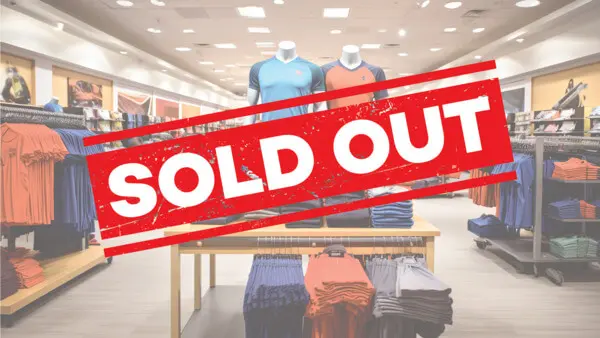Table of contents
Table of contents- The Dynamic Stock Replenishment Revolution
- Paper huh? How very 1990s
- There was either too much or too little on the shelves
- From 2010, things changed even further
- 5 benefits of embracing tech in your replenishment policy
- A unified perspective on replenishment policy
- How do you create an optimal replenishment process?
- Dynamic replenishment: a real customer example
- What do you need to build a more responsive replenishment system
- Dynamic stock replenishment is an absolute necessity in today’s retail industry.
- Dynamic stock replenishment
The more successful your retail operation is, the better you need to be at replenishing your stock. It’s all well and good making sales like there’s no tomorrow, but as far as your customers are concerned, there is a tomorrow.
And they’d like more of your wares then too, please.
Whether you’re a ‘physical only’ sales outlet, or an omnichannel player, strong and robust replenishment should be your bread and butter.
The way you manage this replenishment process is one of the key determining factors to your success.
So, how can you make your replenishment a force for good?
How can you make it dynamic and automated? And what advanced supply chain tools exist to take your retail processes to the next level?
Paper huh? How very 1990s
Until about the end of the last century, replenishing your shop involved paper. And a lot of it.
Just as every receipt you handed out was physical, so too were order books. Gargantuan lists of all the products you could reorder.
Someone would shuffle around the shop, make a note of what was needed and fax it to head office.
They were simpler times. But certainly not better.
Your ability to restock accurately and efficiently depended on the gut feeling and analytical ability of the person placing the orders ‘on sight’. Quite a lot of responsibility for one person.
Luckily, that person’s job became a whole lot easier with the rise of advanced digital technologies.
Retail chains implemented enterprise-wide ERP systems and automated POS systems that automatically tracked inventory levels and shop sales. The result: a far more efficient planning process.
Based on a static and rigid min/max system, the ERP could calculate for itself which products, and how many, needed to be replenished for a specific shop. While this made your ordering process more efficient, it couldn’t improve the quality of your replenishment decisions.
There was either too much or too little on the shelves
A static ERP system makes little commercial sense. It doesn’t predict trends and it doesn’t account for seasonal fluctuation. It simply orders by your minimum and maximum parameters. It’s a static solution to a moving problem.
From 2010, things changed even further
A more sophisticated inventory management system became the norm. They were able to forecast demand at a detailed level.
Optimal replenishment orders could be calculated on a per-product, per-store and per-day basis. They could distinguish between online and offline channels, anticipate local sales patterns, seasons, trends, holidays and promotions.
Far more sophisticated than a paper guess checklist faxed over to head office.
Today, the latest generations of supply chain planning software can do everything you need it to as a retailer.
As artificial intelligence (AI) rises to the fore, wielding it in your fight for a perfect replenishment policy can see you optimise your processes without the need for you or your people to interfere.

5 benefits of embracing tech in your replenishment policy
1. 50% fewer ‘no-sales’
You can’t sell what you don’t have. At least directly. Make your replenishment dynamic however and you can reduce the number of no-sales by 50%.
2. Less stock
If you don’t know how much stock you need, you’ll add 15% on as a buffer. It’s a tale as old as time. Guessing leads to excess stock.
And excess means margin left on the table. You’ll see higher inventory costs, obsolescence and unnecessary discounts.
3. Fewer losses
If your products have a shelf life, shrinkage is one of your biggest killers. Certainly from a margin perspective. Dynamic ordering systems give you better forecasting, differentiated service levels and smarter replenishment. And a reduction in shrinkage by 30%.
4. Efficient logistics
Dynamic shop replenishment can reduce your number of order lines by up to 30%. You’ll see thicker flows with fewer order picks, which increases efficiency throughout the chain.
5. A better brand image
Are your shelves half full? Or half empty? The answer’s a matter of perspective but either looks bad. Well-stocked shelves and full product lines leave a nicer taste in the mouth of your customer.
A unified perspective on replenishment policy
Like many aspects of supply chain, there’s no one size fits all approach to dynamic stock replenishment. You’ll find varying ‘best practices’ depending on industry, company size, department, niche and sub-sector.
Even within one company, people with different functions look at inventory differently.
Your Finance Director, for example, wants the lowest possible capital expenditure and transport costs. The commercial department wants as much stock on the shelves as possible.
Whereas Logistics will just want efficiency.
The challenge for you, as someone in charge of supply chain success is weighing these interests against each other.

How do you create an optimal replenishment process?
Here’s 3 steps to find an optimally functioning replenishment operation.
Step 1: Define your stock strategy
Every retail company should have a strategy to define which customer promise it wants to fulfil and how it wants to differentiate itself.
Here is the critical question, are you going for customer intimacy? Product leadership? Or operational excellence?
Your answer will make a big difference to your process.
Within a retail strategy, outlining the service levels you’re aiming for, in different product categories and sales channels will see it succeed. And this is a top-down approach.
Your business leaders must do just that… lead it.
They should also set a precedent on presentation stock. Do you have nice full shelves? Or sparse and selective? What observations will your customers make about each option?
You wouldn’t accuse a luxury goods retailer of harming their brand with fewer items on show. With a supermarket, you might.
Your stocking strategy is a derivative of your wider corporate vision..
Step 2: Translate strategy into tactical decision rules
Once you’ve defined your strategy, you can set up your replenishment system. A crucial part of this is the forecast function that calculates expected sales per item and per store.
Your system must be able to calculate accurate replenishment orders based on robust forecasts, current stock levels and your business parameters..
A good process looks like this:
1. What is the sales forecast for the item in that shop?
Based on trend patterns, seasons, holidays, life cycle and planned promotions
2. What is the optimal stock per item and per shop?
Based on desired service level, safety stock and presentation stock
3. What is the optimal replenishment order for this item and this shop?
Taking into account logistics capacity, scarcity of stock, risk of shrinkage, replenishment intervals per shop and optimal order quantities.
Whatever business you’re in, the more you can automate, the quicker and better you’ll be. You wouldn’t manage your accounts with mental arithmetic.
A good inventory management system can work better and much faster than you can.
Step 3: Empower your people to make better decisions
Just because you have a sophisticated supply chain planning system doesn’t mean your human planners are on the chopping block.
You’ll still need your people. In fact, their role is far more important.
In a perfect world, your replenishment process would run smoothly. Availability would be flawless, and forecasts reliable. Your trucks would be full and suppliers on time. Things rarely go this smoothly.
Maybe a product suddenly sells much faster than expected? What if a supplier can’t fulfil its deliveries? Or perhaps a promotion doesn’t catch on?
As the machine does the heavy lifting, your people must re-focus their time on monitoring performance to identify opportunities and anticipate risks.
Dynamic replenishment: a real customer example
With its innovative character and the unique style of its creations, Desigual sets the benchmark in the fashion industry.
Founded in Barcelona in 1984, the retailer has built a network of distribution centres located throughout Europe, America and Asia. Today, Desigual operates in more than 100 countries via a wide variety both physical and digital channels.
By taking advantage of the powerful supply chain planning capabilities with Slim4, Desigual optimised allocation and replenishment throughout its network of stores to attain:
- 4% in-store availability increase
- 27% reduction in stock, freeing up working capital
- Enhanced efficiency throughout the entire store network
What do you need to build a more responsive replenishment system
Get senior management involved
Like virtually anything in your business, if senior heads aren’t involved in the design, implementation and cooperation of a certain practice, it won’t happen.
Whether we talk about employee benefits, diversity initiatives or indeed replenishment processes.
Management’s job is determining the overreaching strategy which ultimately drives your entire approach to replenishment.
Involve your central supply chain team
The best retailers manage their replenishment processes centrally.
A team who doesn’t know what’s going on is doomed to make the wrong decisions. And theoretical knowledge won’t cut the mustard.
Involve them in the day-to-day running of the shop floor and they’ll make better decisions faster and with greater precision.
Make accurate shopping processes
You can have the best replenishment software in the world and still fail to make your business a success if you don’t follow it with the right tasks.
The real work has to be done on the shop floor. That’s where your sales are made. It’s where customers return to your shop.
Are products in the right place? Are they front facing? Are the shelves tidy? Is there a rotten apple amongst the display?
Your staff here play a key role in this and need to be supported as much as possible.
They also have to do their part to support the data with reality. Which, for the most part, there’s no shortcut for.
Make efficiency your top priority
The more efficient you are, the better you are. But efficiency doesn’t start and end in the boardroom. It goes through your entire business like a core.
Good staff are hard to find. And this problem isn’t just an issue for those you employ directly, but your entire supply chain.
Warehouse staff, drivers, shop staff, stock planners; demand for these people is higher than supply. And that means, typically, the quality of those you accept may be lower.
Ensuring your people have all the knowledge and tools at their disposal to do their jobs efficiently is the first step on the path to success. If you find the initial competency of those people lower than normal, it falls on your shoulders to train them properly.
This is also the case for managing scarcity across the business.
Load balancing, which is the manipulation of replenishment orders to make optimal use of available capacity is crucial.
Dynamic stock replenishment is an absolute necessity in today’s retail industry.
If you’re still using paper, you’re a long way behind.
The benefits of embracing tech in your processes are clear and obvious. And software like Slim4 can take your business to levels you currently only dream of.
But software alone won’t change the tide. Take heed of the advice in this article and you won’t go far wrong. And if you need further assistance on your journey, get in touch with us to hear advice from experts who’ve been there and done it.

Dynamic stock replenishment
What is Dynamic Stock Replenishment?
Dynamic Stock Replenishment is a modern, tech-driven approach to inventory management that adapts to real-time demand, sales patterns, and other factors to optimize the replenishment process. This strategy ensures that retail operations maintain the right stock levels and meet customer demands efficiently.
Why is there a need for dynamic stock replenishment in the retail sector?
Traditional methods, like paper-based systems, often resulted in either overstocking or understocking, impacting profitability and customer satisfaction. Dynamic replenishment uses advanced forecasting and automation to adjust stock levels based on various factors like trends, seasons, holidays, and promotions, ensuring better inventory accuracy and management.
How has technology impacted the evolution of stock replenishment?
Technological advancements have brought about enterprise-wide ERP systems, automated POS systems, and sophisticated inventory management tools that track and analyze sales and inventory in real time. The rise of AI further allows for intelligent predictions and optimizations, making the replenishment process more dynamic and responsive.
What benefits can retailers expect from embracing tech-driven replenishment strategies?
Some of the notable benefits include:
- 50% reduction in ‘no-sales’ scenarios.
- Decreased stock levels, reducing excess and waste.
- Reduction in losses, especially in perishable goods, by 30%.
- Improved logistics, reducing order lines by up to 30%.
- A better brand image with consistently well-stocked shelves.
How can retailers implement a dynamic replenishment system?
Retailers can start by defining their stock strategy and understanding their primary business goals. Then, they can translate this strategy into tactical decision rules for their inventory system, making use of advanced software tools to forecast demand and decide optimal stock levels. Finally, they need to empower their employees with knowledge and tools, allowing them to monitor performance, and adjust as needed in real-time.




